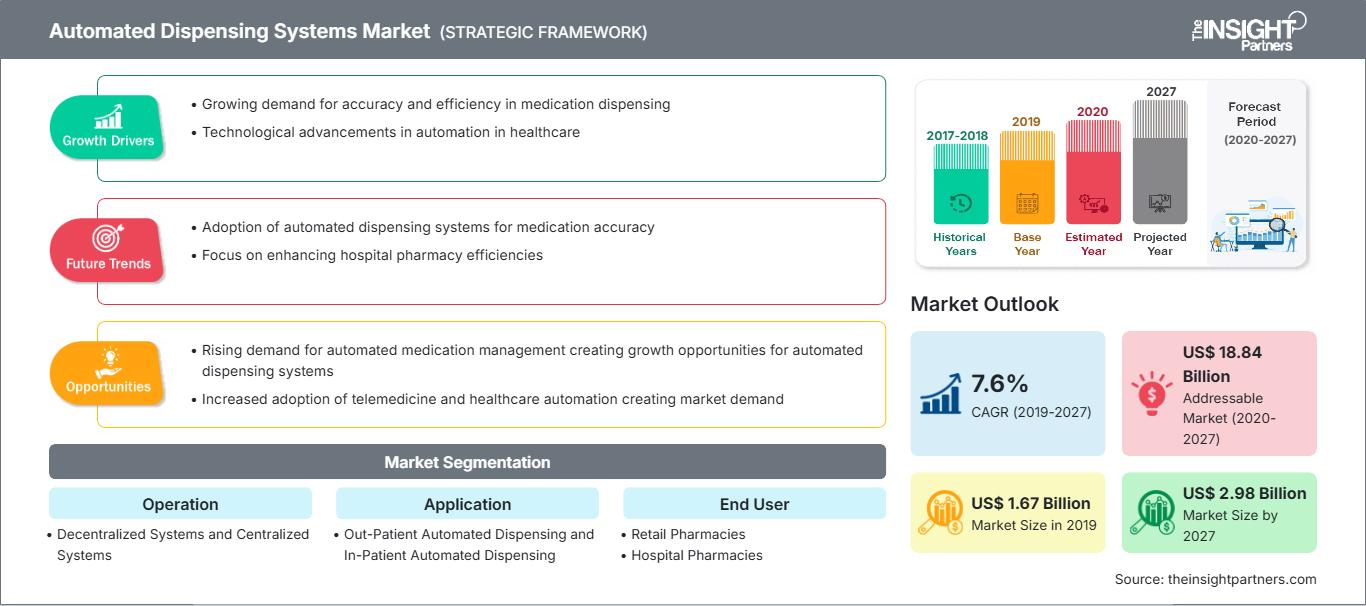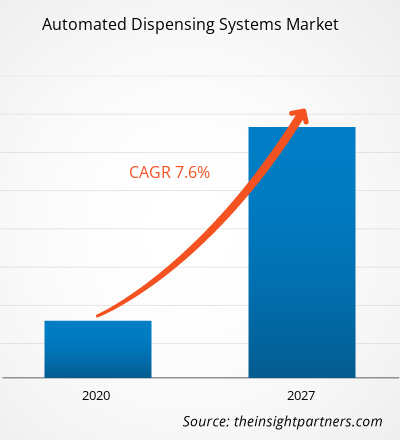自动配药系统市场规模预计将从2019年的16.6578亿美元增至2027年的29.8038亿美元;预计2020年至2027年的复合年增长率将达到7.6%。
自动配药系统,也称为自动药柜,是一种电子药品储存和分配设备,主要用于医疗保健领域。这些系统有助于追踪和控制药品分销;它们采用经过验证的密码和生物识别技术,用于库存控制和药品安全防盗。这些系统被认为是提高运营效率和患者安全的潜在工具之一。此外,它们目前广泛应用于诊所、疗养院等。自动配药系统有助于将医院转变为更安全、更高效的机构。
全球自动配药系统市场的发展受到用药错误增多和老年人口增长等因素的驱动。然而,自动分配系统相关的问题,例如程序输入错误、设备故障等,可能会阻碍市场增长。此外,新兴市场正在为市场参与者创造增长机会。
自定义此报告以满足您的要求
您将免费获得任何报告的定制,包括本报告的部分内容,或国家级分析、Excel 数据包,以及为初创企业和大学提供超值优惠和折扣
自动分配系统市场: 战略洞察

- 获取本报告的主要市场趋势。这个免费样本将包括数据分析,从市场趋势到估计和预测。
您将免费获得任何报告的定制,包括本报告的部分内容,或国家级分析、Excel 数据包,以及为初创企业和大学提供超值优惠和折扣
自动分配系统市场: 战略洞察

- 获取本报告的主要市场趋势。这个免费样本将包括数据分析,从市场趋势到估计和预测。
市场洞察
用药错误日益增多
不合理、不恰当和无效的药物分配可能导致严重的用药错误,从而损害患者的利益。一些常见的用药错误包括配错药品、配错药品数量、配错浓度以及遗漏药品。约 75% 的用药错误是由于医护人员分心造成的,因为他们需要同时处理多项任务,例如检查患者、与顾问沟通、与患者家属沟通以及与保险专业人员交谈。
美国食品药品监督管理局 (FDA) 每年收到超过 100,000 份与用药错误相关的报告。此外,根据 2020 年 6 月在 StatPearls 上发表的“用药错误”研究,每年美国约有 7,000 至 9,000 人死于用药错误。同样,根据 2018 年研究报告《英格兰 NHS 用药错误的普遍性和经济负担》中公布的估计,NHS 每年发生约 2.37 亿起用药错误,可避免的药物不良反应 (ADR) 导致数百人死亡。
基于运营的洞察
根据运营,自动配药系统市场细分为分散式系统和集中式系统。由于降低成本、确保药品供应和实现资源配置现代化等因素日益增长,集中式系统部分在 2019 年占据了更大的市场份额。此外,预计在预测期内,分散式系统将在市场上实现更高的复合年增长率。
基于应用的洞察
根据应用,自动配药系统市场细分为住院自动配药和门诊自动配药。 2019年,住院自动配药市场占据了更大的市场份额;然而,预计门诊自动配药市场在预测期内的复合年增长率将更高。
基于最终用户的洞察
根据最终用户,自动配药系统市场细分为医院药房、零售药房和其他。2019年,医院药房市场占据了最大的市场份额;然而,预计零售药房市场在预测期内的复合年增长率最高。
产品发布和审批是企业扩大全球业务范围和产品组合的常用策略;这些策略有助于他们满足日益增长的消费者需求。合作是自动配药系统市场参与者扩大全球客户群的主要策略之一,这也使他们能够在全球范围内维护自己的品牌。
自动分配系统市场区域洞察
The Insight Partners 的分析师已详尽阐述了预测期内影响自动分配系统市场的区域趋势和因素。本节还讨论了北美、欧洲、亚太地区、中东和非洲以及南美和中美洲的自动分配系统市场细分和地域分布。
自动分配系统市场报告范围
| 报告属性 | 细节 |
|---|---|
| 市场规模 2019 | US$ 1.67 Billion |
| 市场规模 2027 | US$ 2.98 Billion |
| 全球复合年增长率 (2019 - 2027) | 7.6% |
| 历史数据 | 2017-2018 |
| 预测期 | 2020-2027 |
| 涵盖的领域 |
By 操作
|
| 覆盖地区和国家 | 北美
|
| 市场领导者和主要公司简介 |
|
自动分配系统市场参与者密度:了解其对业务动态的影响
自动分配系统市场正在快速增长,这得益于终端用户需求的不断增长,而这些需求的驱动因素包括消费者偏好的不断变化、技术进步以及对产品优势的认知度不断提高。随着需求的增长,企业正在扩展产品线,不断创新以满足消费者需求,并抓住新兴趋势,从而进一步推动市场增长。

- 获取 自动分配系统市场 主要参与者概述
全球自动配药系统市场——按操作划分
- 分散式系统
- 集中式系统
全球自动配药系统市场——按应用划分
- 门诊自动配药
- 住院自动配药
全球自动配药系统市场——按最终用户划分
- 零售药店
- 医院药店
- 其他
自动配药系统市场——
北美洲
- 美国
- 加拿大
- 墨西哥
欧洲
- 法国
- 德国
- 意大利
- 英国
- 西班牙
- 欧洲其他地区
亚太地区 (APAC)
- 中国
- 印度
- 韩国
- 日本
- 澳大利亚
- 亚太其他地区
中东和非洲 (MEA)
- 南非
- 沙特阿拉伯
- 阿联酋
- 中东和非洲其他地区
南部和中部美洲
- 巴西
- 阿根廷
- 南美洲其他地区
公司简介
- Cerner Corporation
- Capsa Healthcare
- Omnicell, Inc
- BD
- ARxIUM
- Accu-Chart Plus Healthcare Systems, Inc
- Innovation Associates
- RxMedic Systems, Inc
- Swiss log Holding Ltd
- Willach Pharmacy Solutions GmbH
- 历史分析(2 年)、基准年、预测(7 年)及复合年增长率
- PEST和SWOT分析
- 市场规模、价值/数量 - 全球、区域、国家
- 行业和竞争格局
- Excel 数据集
近期报告
客户评价
购买理由
- 明智的决策
- 了解市场动态
- 竞争分析
- 客户洞察
- 市场预测
- 风险规避
- 战略规划
- 投资论证
- 识别新兴市场
- 优化营销策略
- 提升运营效率
- 顺应监管趋势




















 获取免费样品 - 自动分配系统市场
获取免费样品 - 自动分配系统市场